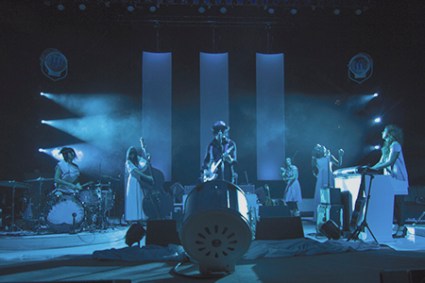Launching his solo career earlier this year with a live performance on SNL and an album, self-produced at his own Third Man Records in Nashville, called Blunderbuss, it’s the first lone wolf venture from an at-times duet rocker, at-times supergrouper, and always-prolific Detroit blues phenom, Jack White.
White sightings popping up around Denver were accompanied with rumors of a secret show to precede his sold-out performance at Red Rocks. The night before his sold-out show, keyboardist Ikey Owens of The Buzzards—one of two backup bands touring with White—was expected to make an appearance at Unit E, a local loft conversion in the Santa Fe Art District. This seemed like as good a lead as any, and Owens did indeed show up to play a great jazz set and eat an entire box of Cap’n Crunch on stage; however White was nowhere to be seen.
A list of location speculations went around, but it wasn’t until the next morning that the texts started coming in, “Jack White. B show. B there. B square,” placing him at an auto-body shop on W. Colfax. Racing across Denver rush hour traffic, we arrived just in time to hear the last of “Ball and a Biscuit” ringing out while he and his Buzzards walked straight through an impromptu crowd and onto their bus, which disappeared into the horizon toward Colorado’s most famous music venue where I would be before the sun set on that Wednesday.
Three hours later, in the Red Rocks Amphitheatre shuttle van, Blunderbuss roadies ruminate on the seven full wardrobe cases traveling with a headcount of fourteen musicians who comprise the two backup bands with White. Listening in, camera in hand, I anticipate a good show. From the photo pit in front of the stage, everything is matte black or white acrylic. Vintage ellipsoidal reflector spotlights holding cucoloris screens cut with White’s trademark triple bar logo stare down onto white sheets in the shape of drums and keyboards. Another, mounted to the floor center stage, gazes up onto a single mic that needs no explanation.
There’s representation here from the kind of urban hipster youth that populated his auto-shop stunt just hours earlier, but the Red Rocks crowd is comprised in part by the older demographic accomplished in that Alt Country/Classic Rock element measured into White’s body of work. I remember listening to an interview where White bemuses the difference between high loyalty regions of the music world like the Country genre, where fans—once earned—remain listeners for a lifetime, and the indie garage rock sphere wherein an artist, no matter how celebrated upon his discovery, becomes the chagrin of its own industry within a year’s time, facing exile to the ranks of the passé. White’s body of work—never more so than on his latest album—exists dead center on the Venn diagram between these two worlds, and while Blunderbuss‘ title track has him singing, “Doing what two people need is never on the menu.” It’s clear here tonight he’s accomplished a momentary coexistence of young and old, classic and contemporary, twang and swagger.
Onstage, men dressed to the 9’s who I at first take for his backing band begin unveiling the instruments underneath the sheets. Every element of a live show contributes to the art of the performance, and only someone who understands that would have his sound engineers dress so well. It’s a bait and switch, and I know it as soon as the men I took for musicians walk offstage and six women in white strut into the spotlight. They’re the Peacocks, the all-girl edition of Blunderbuss‘ alternating backing bands.
I can’t help but think there’s just something about a girl playing bass in a dress, as I watch Catherine Popper swapping between an electric and an upright bass, or the cherub on the church organ by the name of Brooke Waggoner, or Ruby Amanfu, an angel with a voice to match. In white light, the Red Rocks stage looks like some kind of celluloid heaven gone horribly (and wonderfully) wrong, and if this is the pearly gates, the Peacocks are White’s sanctification, surrounding the slender black figure that emerges center stage with a crooked smile and Dorian Gray gravitas. They start into “Dead Leaves and the Dirty Ground,” and the seven member army onstage—6 Southern belle sirens and a singular blues adept—have 9,500 people in awe.
As the set picks up, the sloping canyon around the amphitheatre carries currents of Colorado air down its 69 rows of seating and onto the bottle-neck stage at windspeeds that have each Peacock’s hair blowing maniacally while they accompany White’s banshee vibrato on “I’m Slowly Turning Into You.” The triple white monoliths hanging from the trussing behind the band begin to sway wildly in a display that—I can deduce from the well-dressed sound engineers circling frantically like a Buster Keaton film, trying to hold them down—is not part of the show but amid White’s growling guitar looks so scary-cool.
They have a word for when a man surrounds himself with women; it’s called a narcissistic harem. But hell he’s earned it. An article in The Atlantic decries Jack White’s Women Problem, while another in The Guardian defends him against the misinterpretation of his unabashed virility. Friction between the sexes has always been a theme in White’s work, but the dynamic on stage tonight is more of a familial thing. “Like a family band composed of a family with a lot of sisters,” I think to myself as The Peacocks start into “We’re Going To Be Friends.” Singer Joss Stone, who released a slowed-down cover of White’s “Fell In Love With A Girl” recounts a conversation wherein “He told me he loved it and that when he plays it live, he plays my version rather than his own!” When they begin into the cut-time conversion I’m absolutely sold on the reincarnation of Jack White.
“They did a beautiful job painting the inside of this theater to look exactly like the outdoors.” jokes White. When their set is over, a raucus and uproarious Red Rocks crowd simply will not let up, and the band emerges back onstage with White making the exclamation “You weren’t messing around.” The well-dressed roadies run to plug things back in and the band starts into a six-song encore that could be considered a whole new concert unto itself. White plays an extended rendition of “Steady As She Goes,” which I’m almost sure became wholly improvised by the way he walked around to each of his band mates, orchestrating something we probably heard for the first time. Partway through, the girls on drum and bass actually started leaving when they thought the encore was over, but there was more to go, and so they ran laughing back onto the stage.
By the end of the night, he had played a song from each of his records, ending with the address, “It’s that time of night. You’re gonna go home, me and the Peacocks are gonna drive through the desert. I can’t think of anything better than this, though, I tell you the truth.” He starts into American folk standard “Goodnight, Irene,” serenading a sweet goodbye to Colorado. As the man himself says, “Blues is truth,” and Jack White is indeed the real thing.
















